Amazingly flaky, light and tender gluten free pie crust recipe isn’t difficult to make when you use the right ingredients and follow some easy how-to steps with this recipe. In fact, this is THE BEST GLUTEN FREE PIE CRUST RECIPE because it’s the simplest gluten free pie crust recipe and it turns out so well every time.
Only 5 ingredients, one bowl and the confidence to believe in grandma (I mean, grandma is always right), you can’t go wrong with this recipe!
Light and flaky gluten free pie crusts are possible with gfJules Flour!
What’s The Secret to the Best Gluten Free Pie Crust?
I’ll let you in on a little secret: lots of other gluten free pie crust recipes tell you that you have to press the crust in the pan. That’s because you can’t roll their crusts.
Lots will tell you that you have to add sugar. That’s because they’re covering up for gritty tasting gluten free flours.
Lots will tell you that it’s difficult to make a good gluten free pie crust. That’s because … well, because they haven’t tried the best gluten free pie crust recipe — this gluten free pie crust recipe.
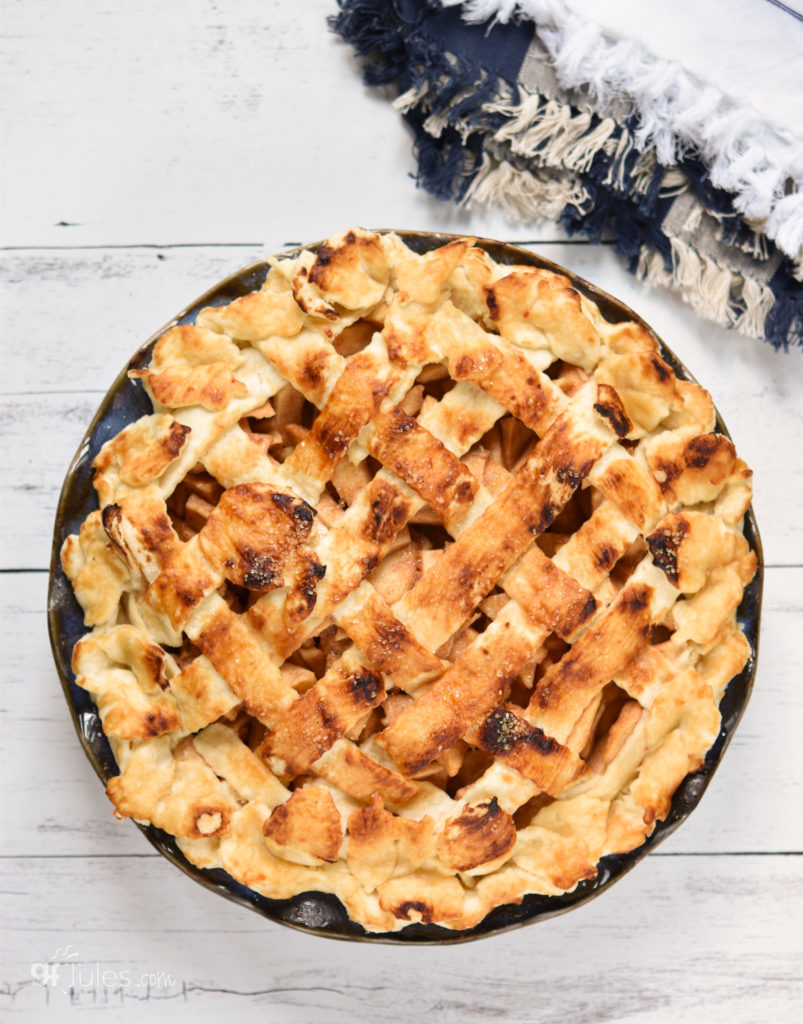
Fair warning: the intro to this recipe is l-o-n-g, NOT because it’s difficult to make a great gluten free pie crust, but because I want to REASSURE you in every possible way (photos & videos) that it’s really quite easy to make the best gluten free pie crust and that YOU can do it!
If you already trust me, then just jump right to the recipe and do exactly as I say. Don’t substitute ingredients and don’t skip any steps. You won’t regret it!
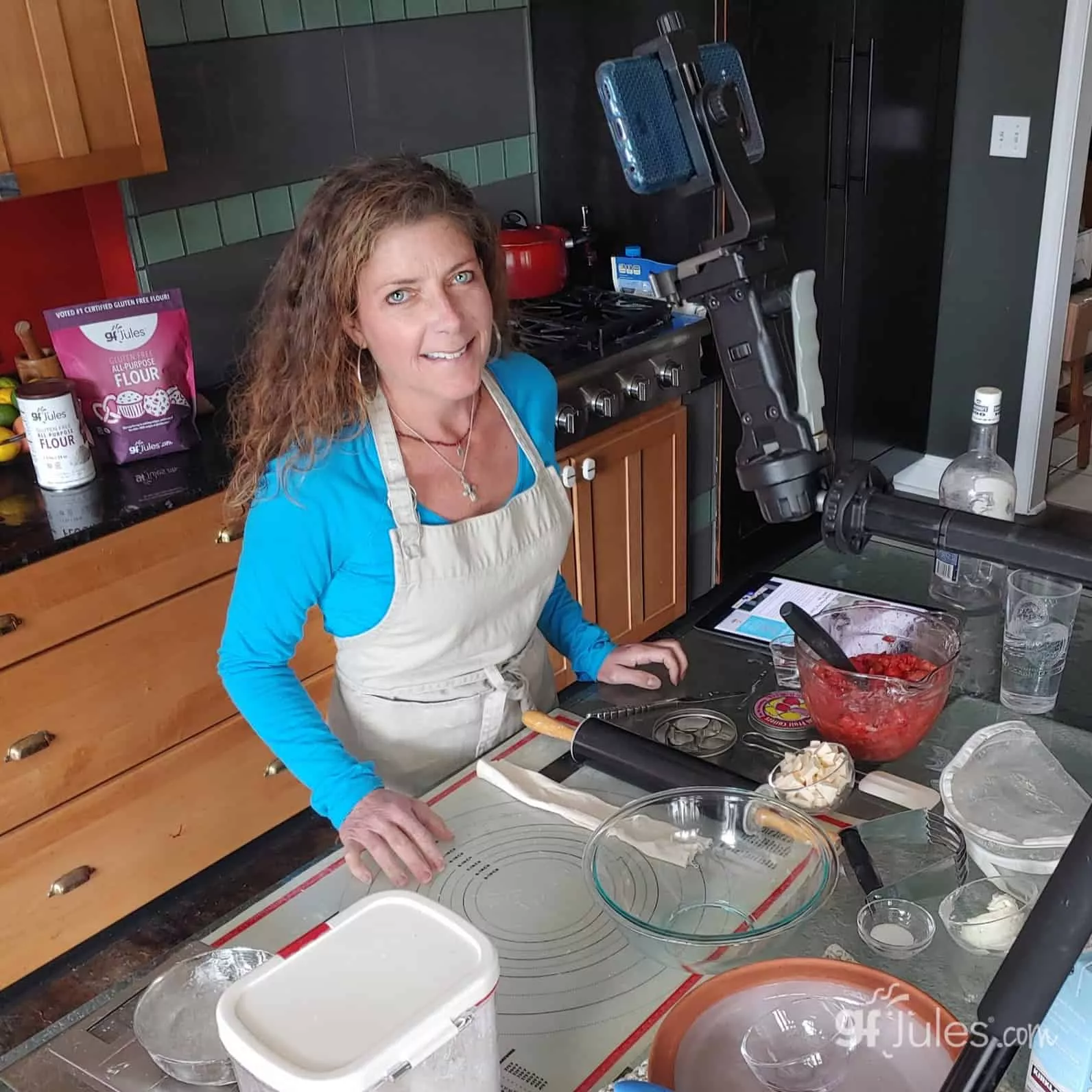
I’ve written out my secrets and tips, I’ve shared my fool-proof gluten free pie crust recipe, I’ve included videos of the steps, I’ve recorded a podcast to walk you through everything you need to know to make a great gluten free pie crust, and I’ve shared step-by-step photos so you can consult this post as you make a pastry for yourself.
Don’t let the length of the post scare you — it’s all here to help!
Just look at this gorgeous, flaky gluten free pie crust. It’s within reach, and YOU can make it, even if you’ve never made a homemade pie crust in your life!
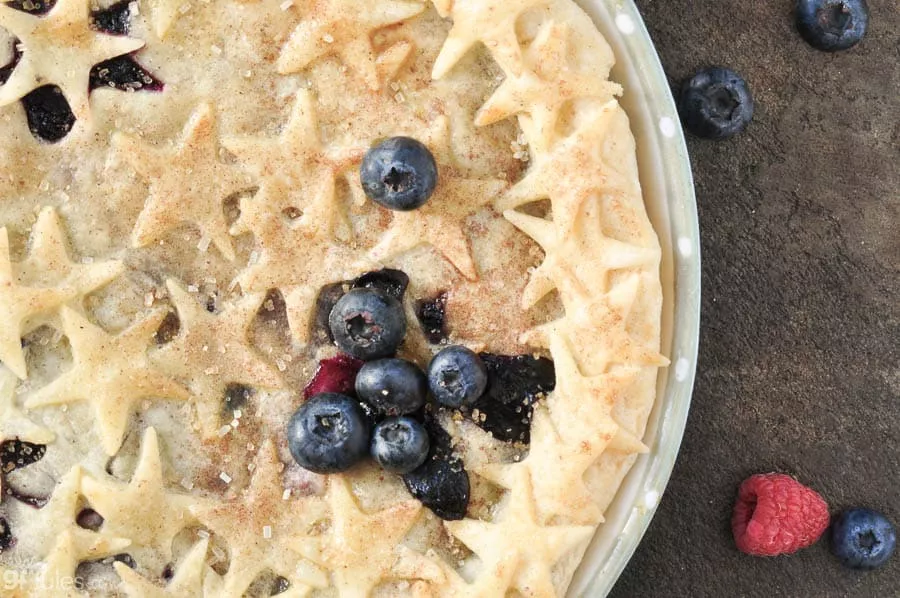
How Do I Make the Best Gluten Free Pie Crust?
I’m here to SHOW you how to make the best gluten-free pie crust with a simple recipe, photos, video and even a podcast! I’ve traveled the country speaking to gluten-free groups and teaching gluten-free cooking classes, and it seems that rolling out pie crusts is the one thing that scares people the most about baking gluten free. There are many techniques I’ve developed over the years, and I’ve gotten it down to quite a science!
One way many folks find it easy to roll out and transfer crusts is by using a pie crust bag.
Check out this video below.
If you haven’t seen one of these handy kitchen accessories, take a look at my video showing how to use them! (You can also find these in my store)
Another favorite of mine is using a silicone or cloth pastry mat and my favorite rolling pin covers. Together, they are so versatile and make it easy to transfer gluten-free pie crusts or to roll out sugar cookies or ravioli or or or … you get the idea!
Here’s a quick video of how to transfer a gluten free pie crust using a rolling pin and a silicone mat.
I also have a video showing how to use these mats and rolling pin covers for rolling out gluten-free pie crusts.
Consult my recipe below and be sure to look at the step-by-step photos at the bottom, where I show how to transfer the crust.
Because doughs made with my gfJules Flour actually have STRETCH to them, it makes it easy (yes, easy!) to transfer pie crust without tears! (Or maybe that was just me who cried over broken, crumbly gluten free pie crusts when I first got started???)
But the most important trick to making a deliciously flaky and remarkably easy-to-roll-out gluten-free pie crust, is to start with the right ingredients.

What Ingredients Make The Best Gluten Free Pie Crust?
gfJules™ All Purpose Gluten Free Flour hands-down makes the best gluten free pie crust. It’s already light and clean and grit-free. The special blend of gluten-free flours and xanthan gum gives doughs extra stretch, making it far easier to roll and transfer top and bottom crusts.
A combination of butter (or non-dairy alternative like Miyoko’s Vegan Butter or lactose free Green Valley Organics® Lactose Free Butter) as well as shortening makes for a flakier crust. Note: I do NOT like using coconut oil in place of shortening. It doesn’t play nicely with the flour and makes for an oily dough that is more brittle and sticky — no fun to work with!

Using cold water and a surprise secret ingredient that no one will ever taste (spoiler alert: secret ingredient is vodka or other distilled grain alcohol) also makes it easier to work with the dough, and yields an amazingly delicious crust that’s flaky and soft every time. (And yes, the secret ingredient is gluten-free, of course!)
This secret ingredient is IMPORTANT. Please use it, as well as shortening + butter, as well as gfJules Flour to achieve the lightest, softest, flakiest gluten-free pie crust. If you cannot use the secret vodka ingredient, use white vinegar in its place for the most tender crusts.
Why Don’t Gluten Free Pie Crusts Brown Like Gluten Crusts Do?
Gluten-free pie crusts don’t brown like wheat crusts because they have less protein in the flour. If you don’t add sugar to the crust or brush the top of the crust with egg wash or something with protein in it, there’s nothing to brown, but don’t let that fool you into thinking your crust isn’t cooked! DO NOT OVERCOOK YOUR PIES.
If you wait for your gluten-free pastry to brown before you take it out of the oven, it will become hard and over-cooked. This is one reason it’s important to brush your crust before baking with either egg wash (one whole egg, mixed, plus 1 tablespoon water or milk) OR milk so that the crust won’t dry out while cooking and will brown more.
The egg wash or milk will be what browns, not the flour crust. You can also sprinkle cinnamon-sugar on your crust for more color, if you like.
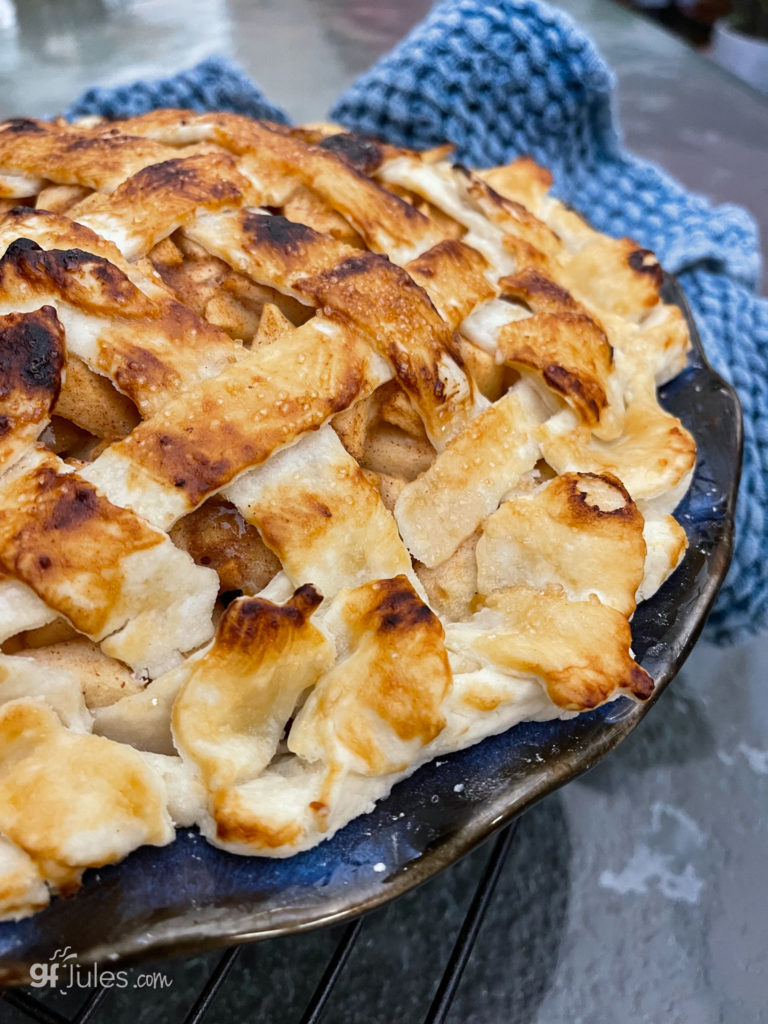
FAQs for Gluten-Free Pie Crusts
I find myself answering lots of emails in advance of pie baking season and folks are all worried that they’ll make a tough pastry crust.
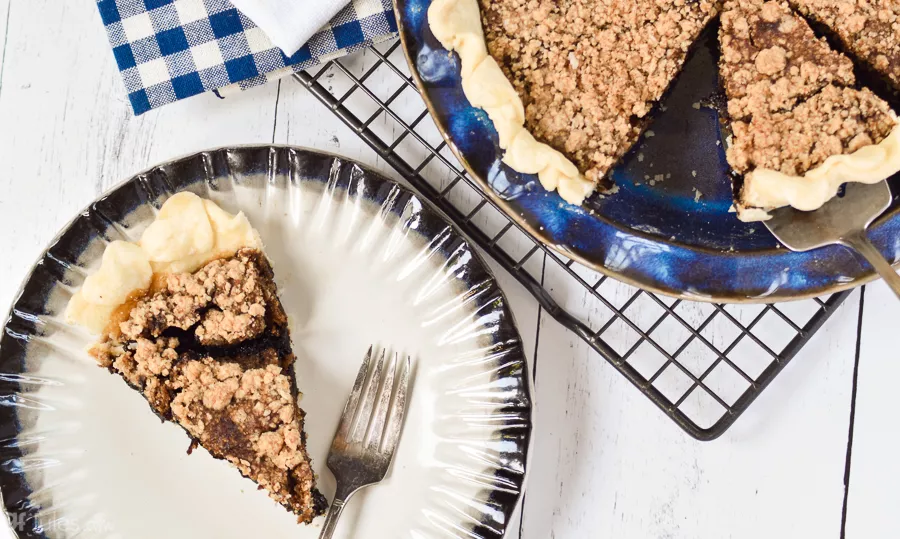
In answer, I usually write pretty much the same things, so I’ll copy a note I wrote recently below, as it’s a good recap of the main tips for making the best gluten-free pie crust.
Top Tips for how to get the flakiest gluten-free pie crust:
- For the flakiest gluten free pastries, make sure the butter is super cold when adding it. I like to cut it into pieces and then put it in the freezer while I’m measuring the flour and getting everything ready. Be sure to measure your flour properly for this, and every gluten free recipe. It’s super important!

Gluten Free Apple Pie baked in Emile Henry Pie Plate. - When you add the butter, cut both it and the shortening into the flour/salt mixture with a pastry cutter or two knives cutting against one another, and only cut it as much as you need to integrate the fats into the flour into small balls, without working it too much. Then add the vodka or vinegar or cold water (start with only 3Tbs) and mix with a fork, adding only as much more cold water as you need to get the dough to hold together without being wet. A wet dough is a heavy dough and you don’t want that!

- Then wrap the dough in cling wrap and leave on the counter for 30 minutes if it’s not too warm in the kitchen, or refrigerate for about 10-15 minutes if you think you worked it too much or the kitchen is warm.
-
Roll it out and into the pie pan and then … I’ve found that covering the crust with wrap again in the pan and putting it in the freezer while you work on other things, THEN filling the crust, is a great way to keep those fats nice and cold before baking.
-
The steam that is generated from the fats melting in the oven is what causes most of the flakiness, so if you have lots of little balls of fat throughout the crust, as opposed to melty strands of fat, it creates more flakiness.
-
That being said, overcooking the crust can also make it tough, so brush the crust with egg or milk to help it brown so you aren’t tempted to leave it in the oven too long, waiting for it to brown.

See below for step-by-step photos!
Here are some videos showing the recipe in action
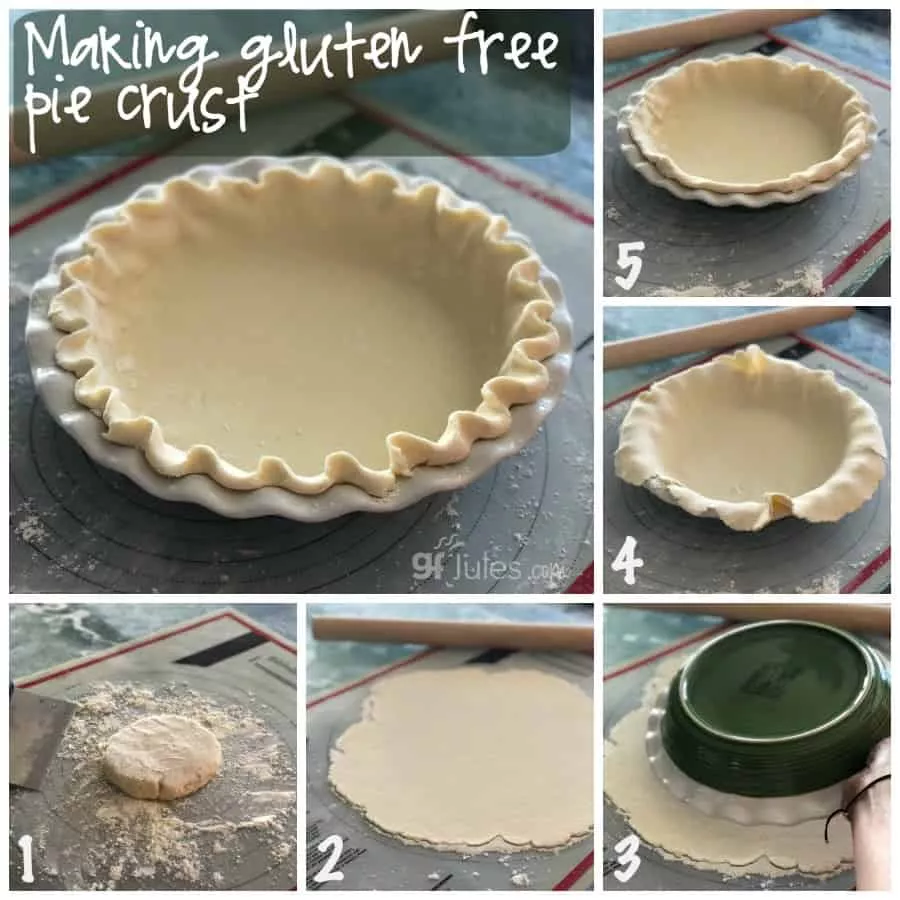
The BEST Gluten Free Pie Crust Recipe
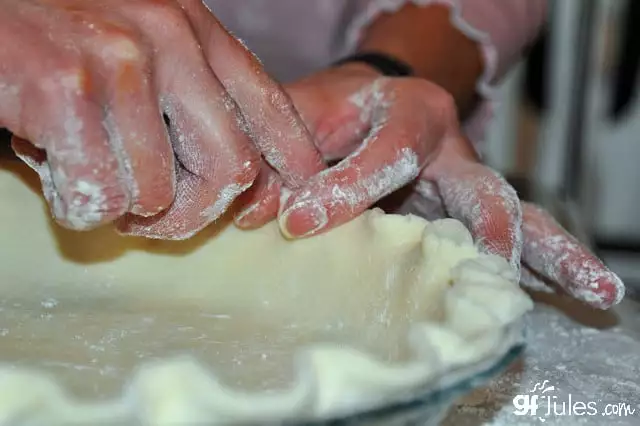
Gluten Free Pie Crust Recipe and Tips
Equipment
Ingredients
1 Gluten Free Pie Crust (double for 2-crust pie)
- 1 (135) cup (grams) gfJules® All-Purpose Gluten Free Flour
- 1/2 teaspoon sea salt
- 2 (1) Tbs (ounce) shortening OR lard OR cream cheese/vegan cream cheese (1 1/8 ounce) (I recommend Spectrum® Organic Palm Shortening*
- 3 (1 ½) Tbs (ounce) COLD butter or non-dairy alternative
- 3 Tbs vodka** (OR white vinegar)
- 1-2 Tbs cold water add more or less to get the dough to hold together but not be sticky
- egg wash (1 egg + 1 Tbs. water) OR milk (dairy or non-dairy) for brushing on crust
Instructions
To Make the Dough:
- In a large bowl, whisk together the dry ingredients.
- Cut in the shortening/cream cheese and cold (not frozen, but very cold) butter using a pastry cutter (or the flat paddle attachment on a stand mixer or a food processor).
- Add the vodka & water gradually to make the consistency you need to form a ball -- err on the side of it being wetter rather than crumbly, but only add the liquid you need to get it to hold together, not too much! Do not over-work the dough, or it may become tough when baked.
- Form a disc with the dough, wrap in plastic and set aside on the counter for 30 minutes or refrigerate while you make your filling.
Rolling the Dough:
- After allowing the dough to rest, roll the pastry out onto a surface dusted well with gfJules All Purpose Gluten Free Flour.
- Use a flexible pastry mat (e.g. Silpat or cloth mat) and rolling pin covers or a pie crust bag for rolling and transferring your gluten free crust easily.
- Gently roll in each direction — do not press down on the pin while rolling — to a circle with a diameter at least 1 inch larger than that of your pie pan.
- Click on the pictures above the recipe card for quick videos on how to easily transfer a gluten free pie crust into the pan.
To Transfer the Crust:
- 1- Gently lift an edge of the rolled out crust over your rolling pin. 2 -With one hand under the baking mat, use the pin in the other hand to lift the crust so that it is supported by the rolling pin as you pull the crust gently off of the baking mat. 3- Transfer gently over the pie plate to center. 4- Drop gently into the plate and allow crust to slump into pan. 5- Pat into your pan. (See photo above recipe card)

- For a One Crust PieCut the edges of the crust to an even length of approximately 1-inch larger than the diameter of your pie plate.
- Gently fold the edges under, then press with a fork or spoon or pinch into a fluted design between your fingers. Cover with plastic wrap and freeze while you make your fillings.

- Fill with your desired filling.
- For a Two-Crust PieDouble the ingredients and divide the doubled pie crust dough before setting aside. Shape each half into a disc and wrap each in plastic wrap. Repeat the rolling out steps for the first crust and cover with plastic wrap, then freeze for 30 minutes or while you prepare the fillings. Fill the pie and lay the second crust gently onto the top of the filled pie pan.
- Cut off all but 1/2 – 1 inch of excess pie crust from around the edge of the pan. For fruit pies, cut small slits in the center of the top crust to allow the hot steam to escape. Brush the crust with egg wash or your milk of choice – this step helps it to brown nicely.

- If there are any tears in your top crust, never fear! Simply take leftover crust and use decorative cookie cutters to cut out leaves, pumpkins, etc. Wet the backside of each cut-out with a dab of milk, then lay on top of any tears to cover the flaw.
- Use pie crust shields to prevent crust edges from over-cooking.
- Fold approximately 1/2 inch of excess pie crust over all around the edge to form the crust, then using your fingers, press a fluted design or use a fork to go around the crust to finish.
- Your pie is now ready to bake or to freeze for later baking. For directions on how to freeze the pie dough and bake later, hop to my post on that method. To bake now, follow the instructions below.
- Single-Crust: Preheat oven to 400º F (static). Brush the crust with egg wash or milk, then cover edges with foil or pie crust shields to minimize burning. Bake for 15 minutes. Reduce heat to 375º F (static) and bake an additional 20 minutes, remove the pie crust shields, and bake an additional 10 minutes, or follow directions for your specific pie recipe.
- Double-Crust Pie: Preheat oven to 400º F (static). Brush the crust with egg wash or milk, then cover edges with foil or pie crust shields and bake for 15 minutes.
- Reduce heat to 375º F (static), remove foil and brush again with egg wash or milk. Bake an additional 35-45 minutes, or until the juices are bubbling, or follow directions for your specific pie recipe. (Cover again with foil if the crust is browning too much during the bake).
- Unfilled Pie Crust (Blind Bake): Cover crust in pie plate loosely with plastic wrap and refrigerate for 30 minutes. Preheat oven to 375º F (static).
- Prick the bottom of pastry all over with tines of a fork. Cover the pastry with parchment paper and pour pie weights, dry rice or dried beans on top to cover 1 inch. Brush the crust edges with egg wash or milk, then cover crust edges with foil or pie crust shields. Bake for 15 minutes or until the bottom of the crust no longer looks raw.

- Remove the parchment paper and weights. Return to bake for 6-8 minutes if filling with quiche, pumpkin or key lime type filling which will be baked further; for cream pies and refrigerated fillings, bake 10-15 minutes more. Don’t wait for the crust to turn brown before removing or it will have over-cooked. Cool completely on a wire rack before filling for refrigerated pies.
Notes
** Please keep in mind that nutrition information provided is per serving, which may vary. While we have taken care to provide you with the most accurate nutritional values possible, please note that this information may differ significantly depending on the exact ingredients and brands that you choose to use to make this recipe. Additionally, where options are given for ingredients, the resulting calculation may include all ingredient options instead of only one per line, skewing the totals significantly.
I hope you love this recipe as much as we do!
Pin it for later!
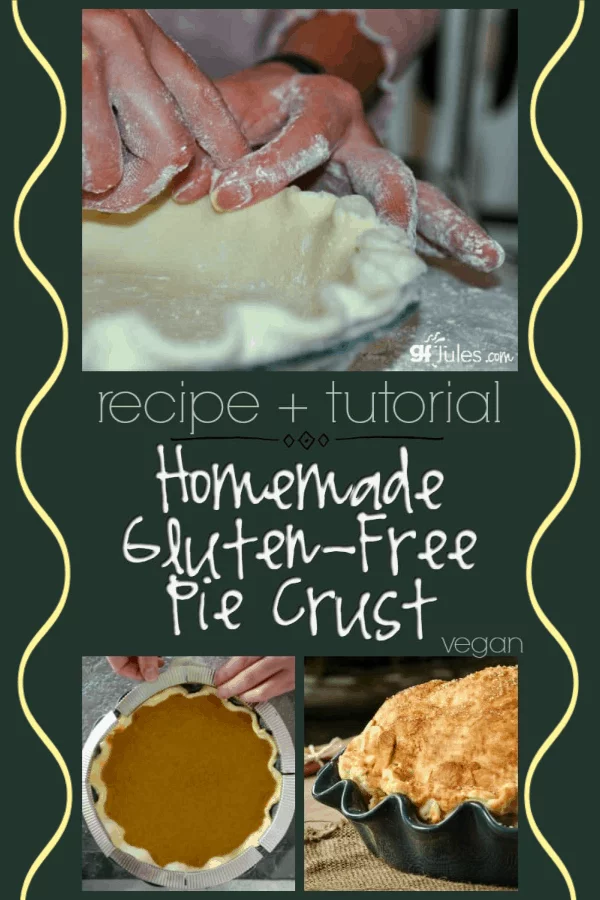
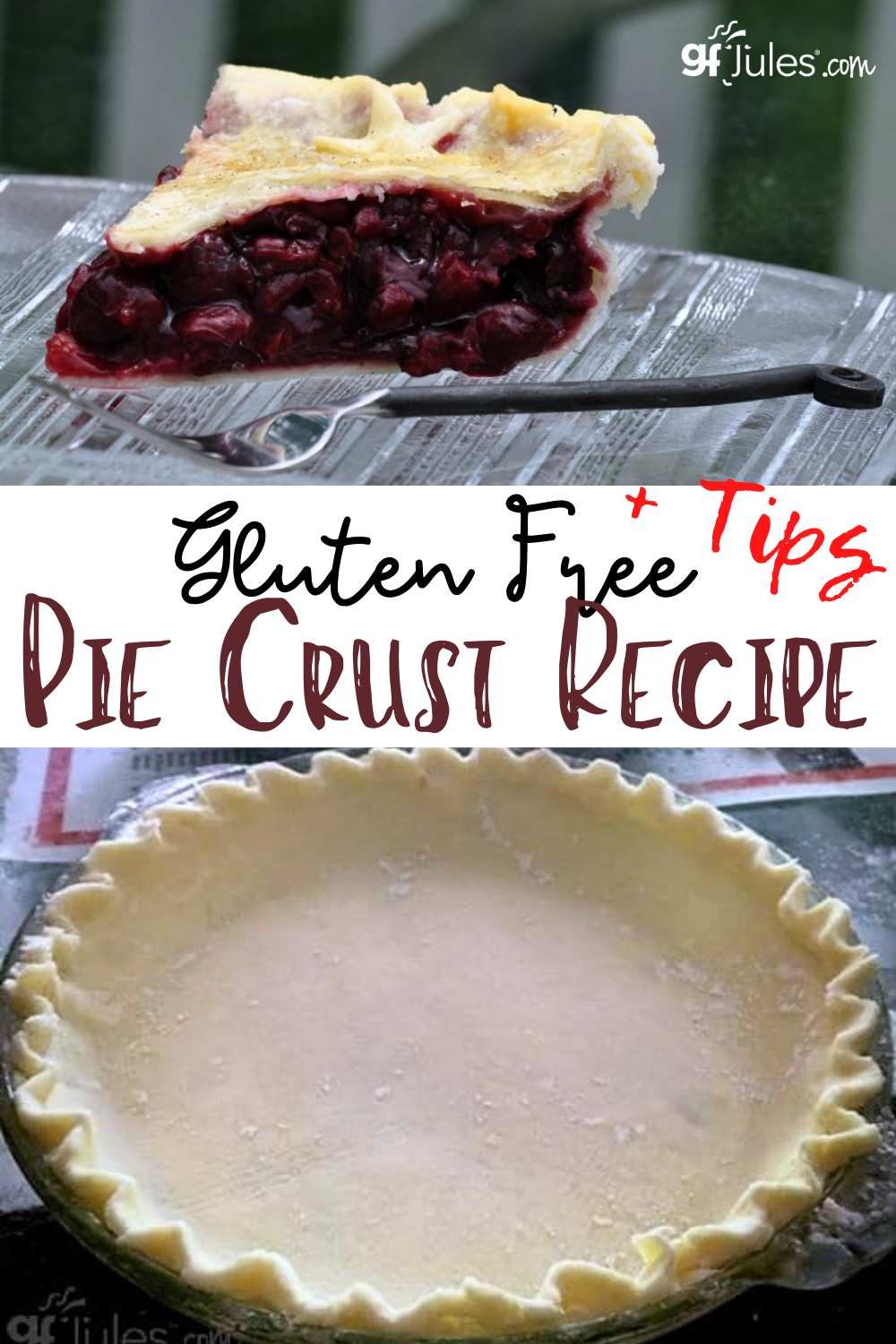

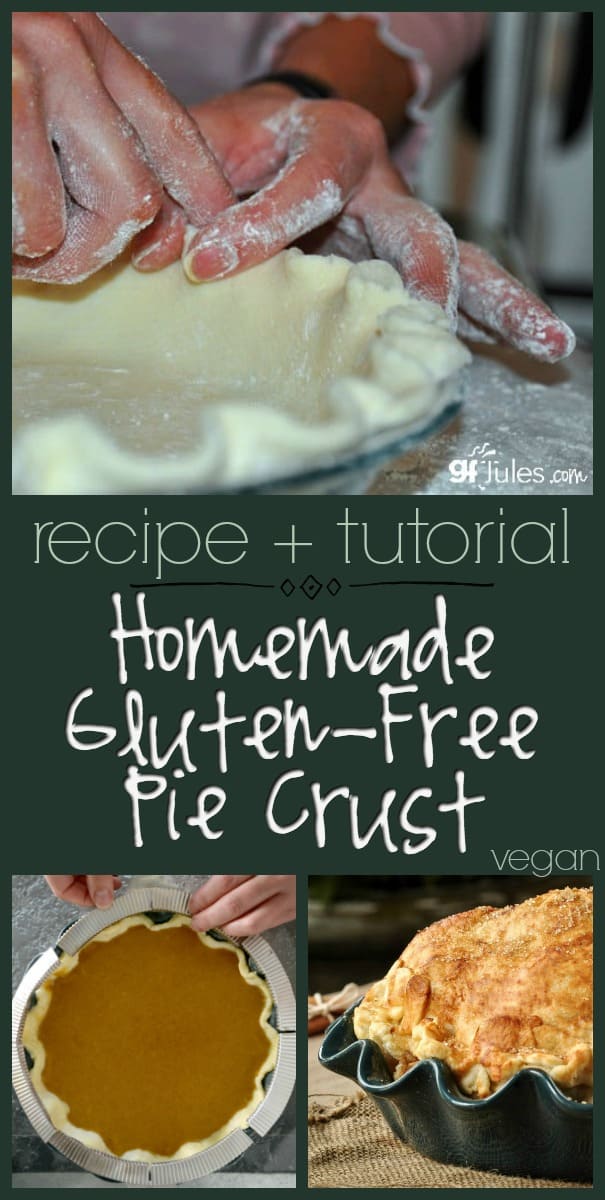

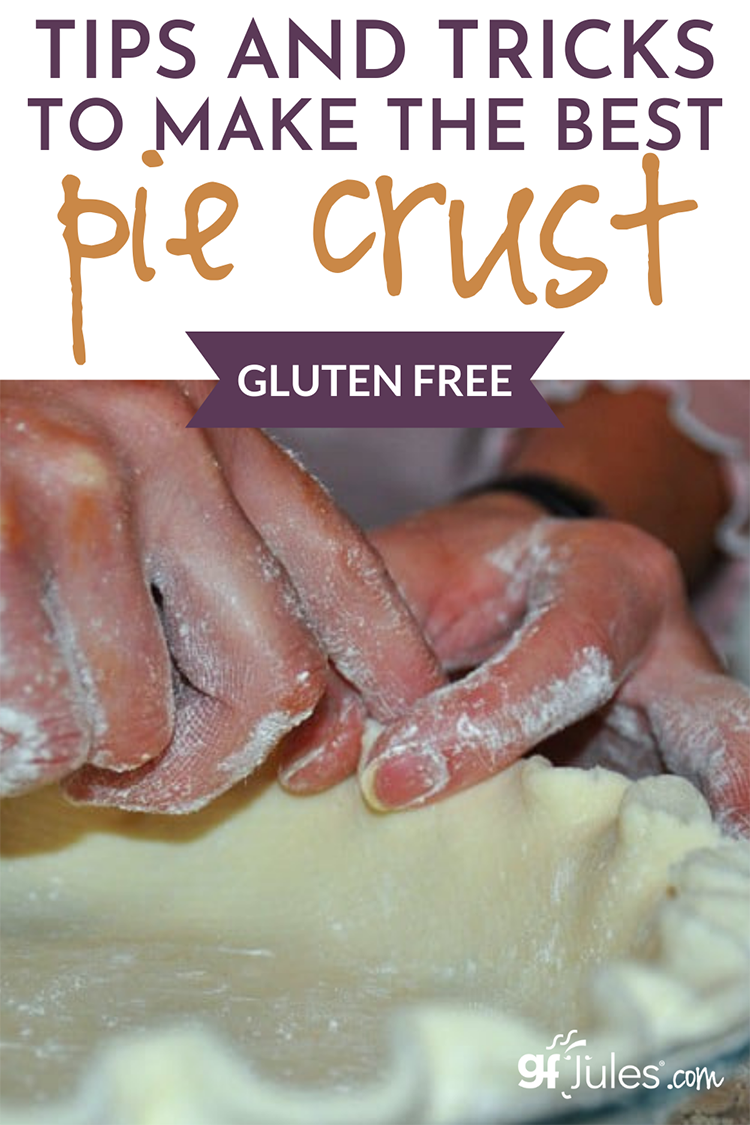
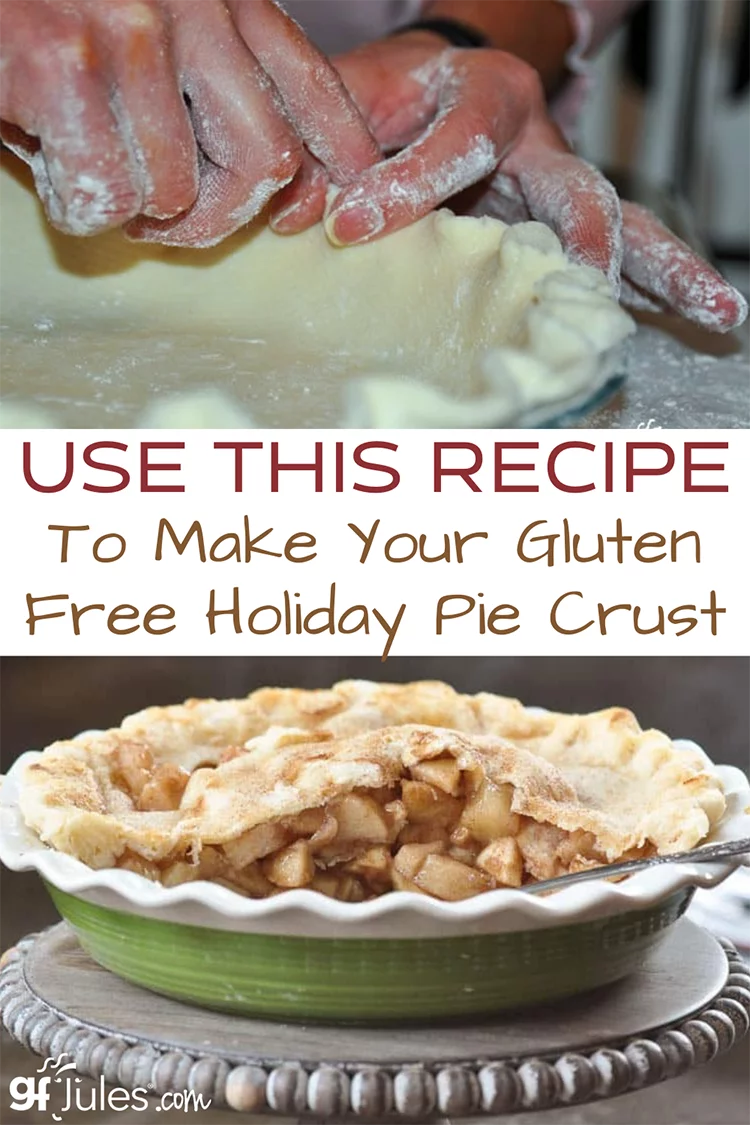


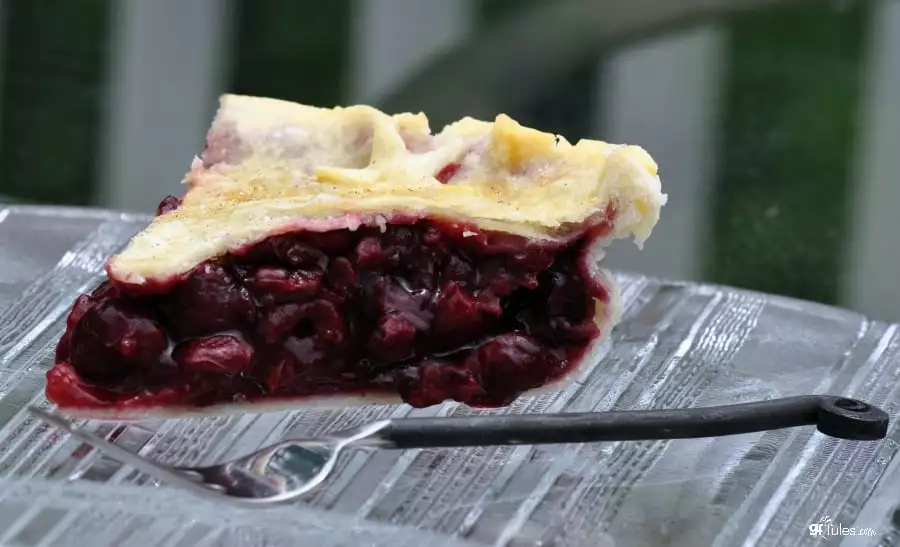

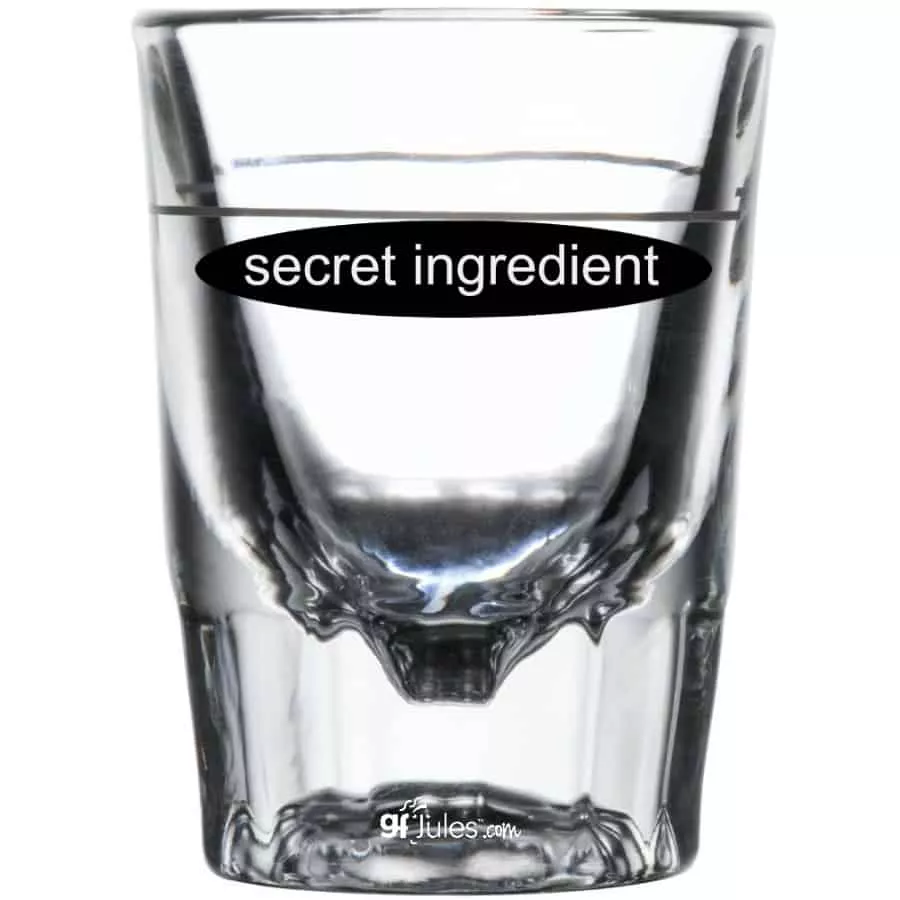
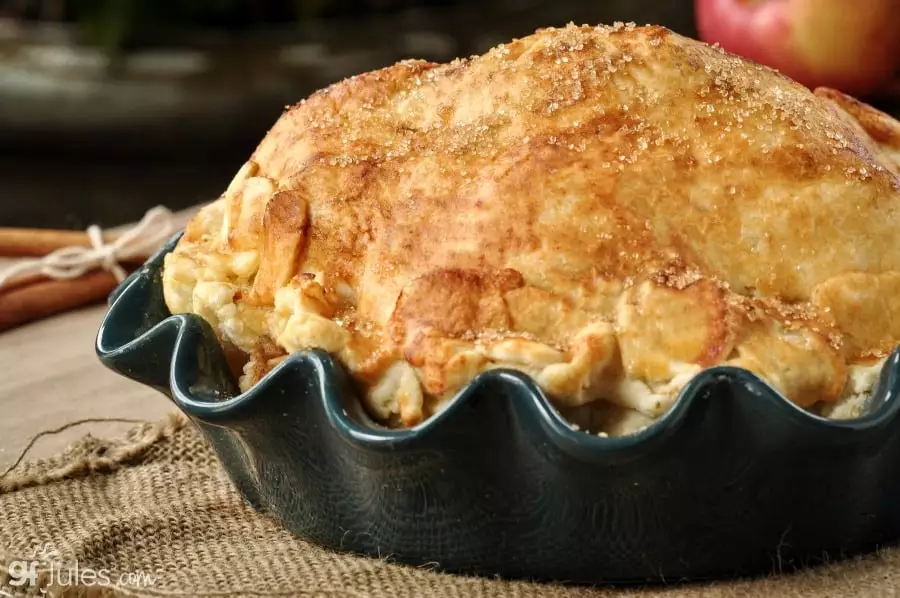
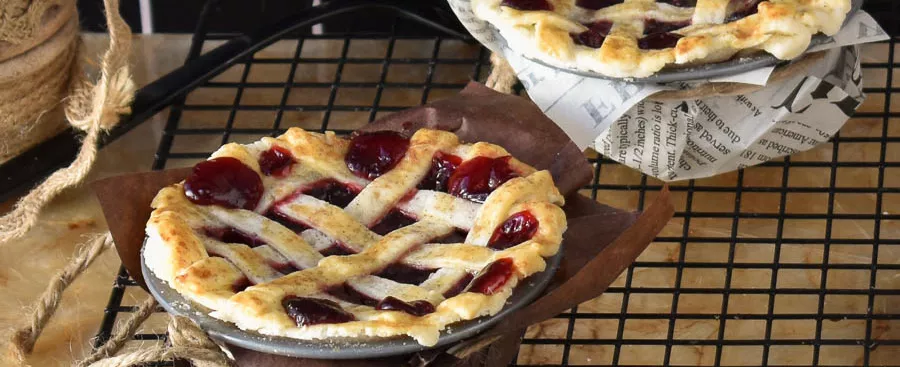
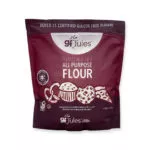














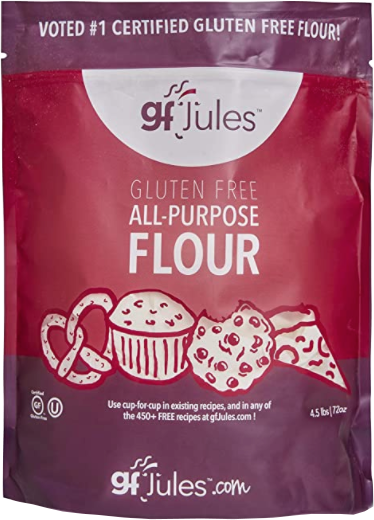
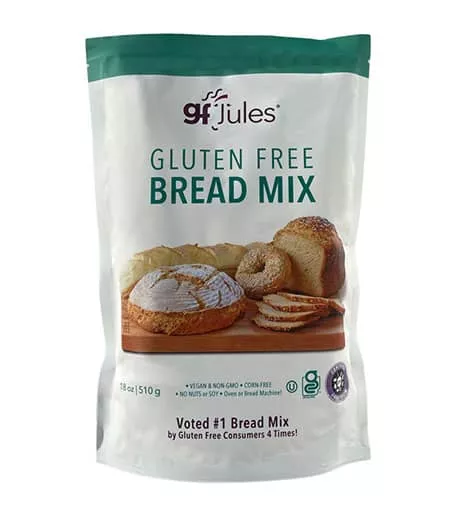

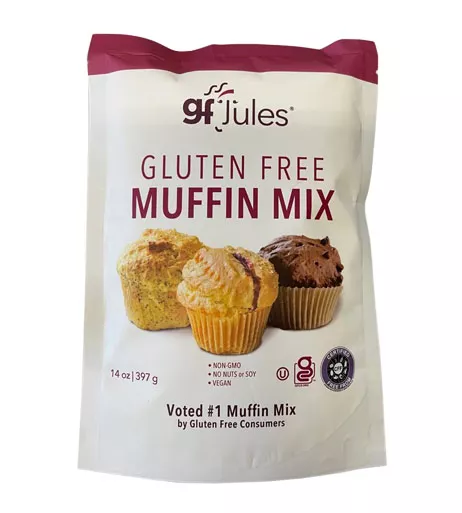


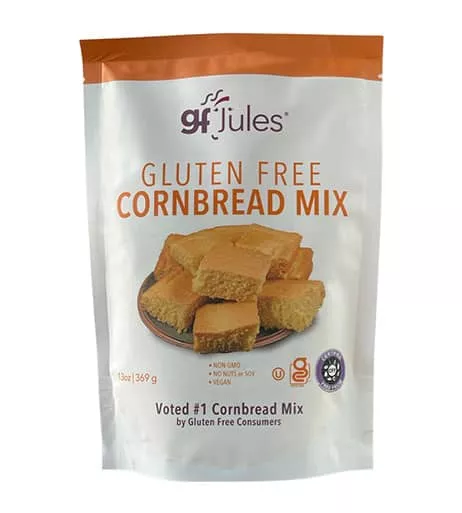



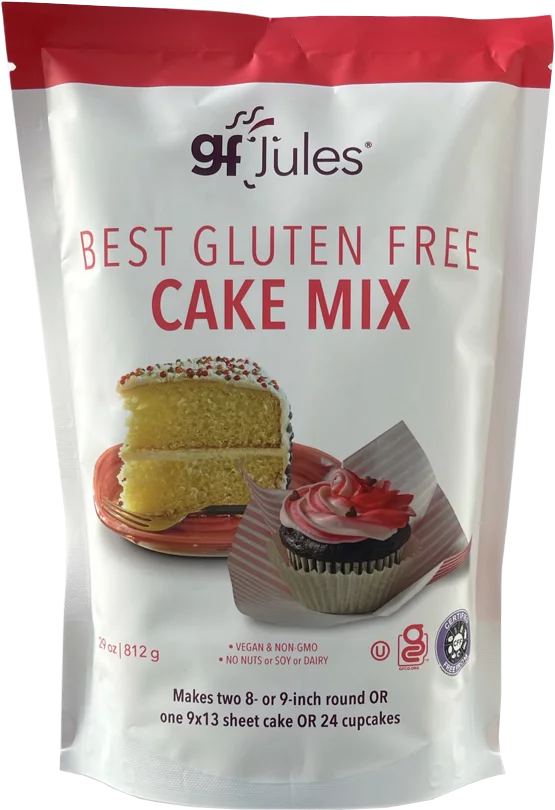
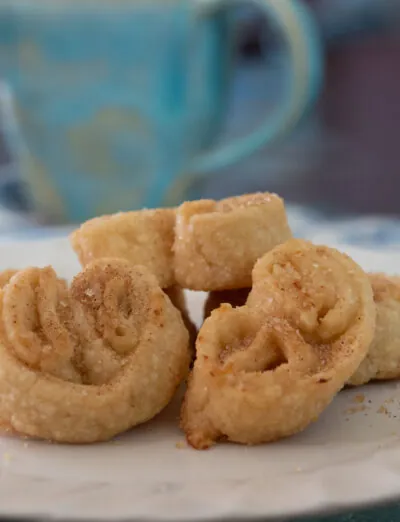

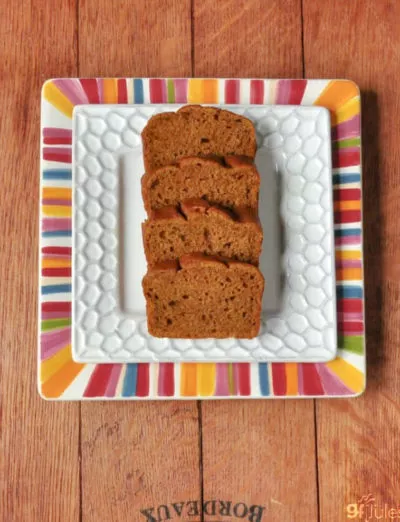
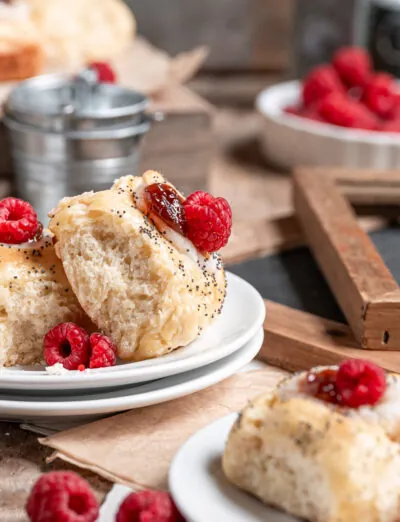







Hi Jules, I started the pie crust and before I got it rolled out I had an emergency and was unable to complete the pie making. I put the dough in the fridge. How long do I need to let it sit out before rolling it out? Or do I not need to do this?
Hi Carol, I hope everything is alright!
Regarding the pie dough, if you let it sit out, still wrapped, until it’s closer to room temp but not quite room temp, the butter will still be cold but it will be less crumbly and difficult to roll out. When it’s really cold, it can be hard to roll out without it cracking.
~jules
Hi Jules,
Thank you so much for providing such a great gf resource! I’m trying to sharpen my gf pie chops before the holidays. Ive made a couple pies following your instructions but have run into a problem with the bits of vegan butter/shortening melting and leaving holes in my crust. I used a combo of miyokos and spectrum shortening as well as water and vinegar, all chilled in the freezer. I blended the miyokos/shortening into pea sized (or smaller) pieces with a pastry cutter, and then used a fork to work in the liquids and form the dough as you demonstrate in your video. I understand that overworking the dough can be a problem, but am i erring on the side of underworking the dough?
Hi David, so glad you’re getting a jump on pie baking for the holidays! It sounds like maybe the issue is freezing the shortening, and perhaps even the butter. You definitely don’t want to overwork the dough and freezing the butter can help that if you have it already in small pieces or grate it into the dough (even better, when using frozen butter). The shortening, however, need not be frozen. That might be causing a problem. Maybe next time try grating the frozen butter and use shortening at room temp. That should allow you to mix it in easily without over-mixing and certainly without leaving any large pieces. If there are holes, I’m imagining that there must be larger pieces of butter or shortening left in your dough that have not been cut up. There should not be any pieces smaller than baby peas. Hopefully that will fix it!
~jules
I used it to make these peach hand pies. I doubled the recipe and used vinegar instead of vodka and all butter because that’s what I had on hand. Between my two grandsons and my husband, they lasted almost 30 minutes! Your flour is all I use to bake with! Bless you and happy holidays!
Carla, these gluten free hand pies look FANTASTIC! You could be the envy of any neighborhood bakery — no wonder they were gone in a flash! Thanks so much for taking the time to share a photo as well as how you made the gluten free crust recipe. I’m so pleased to hear that my gfJules Flour is helping you to bake all your recipes happily!!!
~jules
Hi I absolutely love your flour and have used it for a few years now. I’ve started making pie crust, following your instructions. When I roll my dough out and get ready to transfer it to the pie plate, it falls apart on me so I end up rolling it out again and as a result the crust is tough. What am I doing wrong?
Hi Kathy, so glad you’re enjoying using my gfJules Flour!!
You’re right that if you over-handle pastry dough like this, it can produce a tough crust because the butter starts to melt and the dough becomes over-worked. Did you make any other substitutions or changes to the recipe, as written? Did you use vodka or just water? Also, do you weigh or measure your flour? What temp was the water and butter? Comparing your crust to the ones in my photos and videos, do you think it was about the same thickness or thinner or thicker?
Based upon the answers to these questions, I think I can guide you about what might help. But this pie crust bag is also a tool that a lot of people find helps them to transfer crusts without breakage, so it’s something you might also want to take a look at!
~jules
Hi Jules, I do make sure I use the exact ingredients, including vodka. My butter and water are always very cold (should the shortening also be cold?) I measure my flour by scoop and level method.
I must admit my crusts look thinner than yours so that could be a problem. I will be ordering your pie crust bag since it looks like it makes transferring pie crust so much easier .
I must say also that everything else I make using your flour turns out beautifully, especially the Yorkshire puddings that are my granddaughters favourite. Thanks so much for replying.
Happy to hear about those Yorkshire Puddings!!!!
Regarding the crust, it could be that you have too much flour in the recipe, since you’re not baking by weight it’s always a bit of an inexact science. A too-thin crust would also lead to breakage. If it falls apart when you transfer it, you could always patch it together rather than re-rolling it since that’s definitely leading to a tougher crust. The other thing though is that you might be baking it too long in general. Especially if you’re rolling a thin pastry, it’s easy to over-bake the crust. Definitely cover the crust edges and don’t wait for them to brown for you to take the pie out. Brush with egg wash or milk to help seal in moisture and for that to brown instead of waiting for the flour to brown, itself. Most people who have tough crust issues are actually baking their crusts too long!
Good luck with the pie bag and let me know how the experiments go. I just posted a new video making a rustic crust on an apple pie — I don’t know if that video will help at all, but you might also take a look!
~jules
I had this pie crust and made it this week. I did one apple crumb and one blueberry. I didn’t see these tips and just followed package. It was amazing. I also have the pie bag for rolling out. It has been the best baking tool. My granddaughter who has celiac wanted more crust. I usually take the cut off trims and bake as a cookie with cinnamon and sugar and she was in 7th heaven! I will definitely be making more pies and pie crust cookies for her!
Fantastic to hear, Marcia! I wrote out all these tips just so that folks had plenty of help and reference points, but the recipe is really quite simple! I’m glad that you found the gluten free pie crust to be so yummy, and also worthy of baking the leftovers as cinnamon cookies!!! I usually roll mine up and bake as little cinnamon rolls, but I might try it as cookies next time!!!! Thanks so much for taking a moment to let me know how much you loved this recipe!
~jules
Hi, Jules,
Usually when I make pumpkin pie, I make a pie crust, fill it with pumpkin mixture and then bake. Can I do that with this recipe? Or should I still bake (or partially) before filling and baking? Thanks!!
Hi Jainnie – you’ll be able to do the same with this crust. Check out my gluten free pumpkin pie recipe for my method and check it against what you’ve traditionally done, but I think you’ll find it very similar. Enjoy!
~jules
Thanks, Jules!
I came here to ask the same question! Thanks Jainnie and Jules 🙂 Trying this homemade crust next week for a pumpkin pie when my mom visits.
why use the vodka in the pie crust? my husband does not eat anything with alcohol. Yes, we know the alcohol bakes off, but alcohol, cooked or not can trigger his gout. What else could be substituted that will give the same results?
Hi Marci, if you read the information about the vodka in the text, there are a few reasons why using it adds to the tenderness of the crust and is beneficial to the recipe. That being said, I’ve also noted that a white vinegar used in its place is a close second as a recipe sub. Hope that helps!
~jules
Any ideas on changing for high altitude? It was difficult to work with. Lots of small pieces. Dough seemed like perfect consistency before I rolled it. I used 4T vodka and about 4.5 water. 2nd crust I added another half T and seemed better and let it sit for 1 hour. It rolled easier but tough. Other thing I may try is letting it sit longer in the fridge with final half hour at room temp. Not sure I can add much water without it being sticky. Thanks for any ideas anyone may have. I’m researching online too.
Hi Melissa, check out my gluten free baking at high altitude tips. Drier air will definitely impact a recipe like this, so you were right to add more liquid. Err on the side of more vodka, as you can add more than water and it will bake out, but still add cautiously so it doesn’t get too wet. If the dough is crumbly or unable to be rolled, you definitely still need to add more. You could also alter the shortening:butter ratio and increase butter and reduce shortening, as there is more moisture in butter. Let me know how it goes!
~jules
I made this with an adaptation of your pot pie recipe. I hate shortening, but I had some bacon grease which I figured I could use for lard. Also, the only vodka here…since we use it for herbal processing, not drinking, is 151 proof! So I used 1 T and subbed water for the second. Not sure what the vodka does, but crust tasted disgusting before baking but was the yummiest, flakiest ever when it was done!!! I actually haven’t had pie crust in about a decade. It was very exciting. Thanks so much!!!
Well Cris, I have to say that I’m glad you went with it and trusted the recipe! Whatever you had to do to get there, you got the yummiest, flakiest gluten free pie crust ever! Congratulations!!! On to baking more pies — that IS exciting!!!! Thanks so much for sharing your results with me! 🙂
~jules
Thank you, Thank you, Thank you! Best pie pumpkin pie I have made in years!!! I didn’t have vodka and used tequila instead and it turned out great!
Fantastic!! I’m thrilled that you went with the tequila and loved the results!!!
~jules
Can I ask you please why the vodka, just curious. Also as I live in the UK I am wondering if this would still be successful using an alternative gf flour? Dove’s is a very popular one here.
Many thanks
Sandra
Hi Sandra, check out the intro to the recipe where I explain in detail about the “vodka trick”! 🙂
I don’t know anything about Dove’s blend, but compare the ingredients to the ratios in this homemade blend outlined in the recipe in this article comparing gluten free flours. Also, we DO ship to the UK, if you ever want to check out costing, just put various items into the cart with your address and see what the sweet spot for shipping might be! Hope that helps. Happy baking!
~jules
I’m going to dive into some pie-making once I get some shortening. Do you have a preference of type or brand. Any good organic one’s out there I can look for?
Cheers and thanks for all the amazing recipes. There are so many I want to try out.
Wonderful, Anna! So glad to hear you’re ready to start some gluten free pie making! I personally really like Spectrum Palm Oil (organic) shortening. It’s linked in my recipe!
~jules
This was the prettiest pie crust I’ve ever made!! I took a picture before I baked it – just in case I dropped it or burned the top 😂. I absolutely love your all purpose gf flour. I’m still learning how to transition the recipes which call for just almond flour though. The moisture level is still off in some of them. I think they are maybe just bad recipes
What a beautiful pie, Kim!!! I love that you took a before photo — just in case! I do that too, but try not to jinx anything! LOL!
So happy you’re loving my gfJules Flour and recipes. I’ll tell you something about using almond flour recipes though: almond flour has a totally different moisture requirement in recipes, as well as fat absorption and needs. SO … I would never recommend using almond flour recipes with my gfJules Flour. My flour was designed to mimic the baking properties of regular all purpose flour, so it works best in recipes calling for regular all purpose wheat flour or of course the recipes in all my cookbooks and here on my gfJules site. I hope that helps. Here’s more information on different gluten free flours. Happy baking!
~jules
Hi Jules, As you requested I am sending this comment about making your GF Jules pie crust. As an experienced and mature (never say old!) woman in her 80’s, I have made hundreds of pie crusts. Since finding your wonderful gluten free products I use only the GF Jules recipe and flour along with the ingredients listed in the recipe. I use the shortening/butter combination. NEVER had a problem until last week! After 2 failed attempts I decided to find out what went wrong. I did everything the same way with the same ingredients as always, including using my food processer. When I added the shortening to the flour/salt mixture I could not get a “crumb” result. When I added my vodka/water to it , it would not process into a smooth ball, just a mess. I decided not to give up. My shortening was not really old (in this case I do use the word “old”), but it was the only variable that I thought might be the culprit. I bought a new, fresh container of Crisco shortening and gave it another try. Yea !!! It turned out beautifully once again. So – if a customer has a problem like I did, not to worry or stop using Jules’ flour. Make sure the shortening is fresh, bright solid white and firm. And best if chilled before using. I love your products. And I love you for making them!!
Thanks so much for sharing your experience, Dona! I hope it will help in case anyone else has troubles making gluten free pie crusts, but also to inspire folks not to give up!!! Very happy you didn’t, and you reaped the rewards of a delicious gluten free pie crust once again!!
Happy baking! xoxo
~jules
Hi Jules,
I have made many a pie crust in my lifetime, and my favorite was the ATK Foolproof Vodka crust. I h ave been gluten free for perhaps 14 years, and keep trying various recipes. It must taste good! I live in Germany, so your gfjules flour is not an option, but I have found a super flour here in Germany that probably is similar, but it doesn’t have Xanthan Gum in it. For a one crust pie, how much Xanthan Gum should I use? I am trying 1/2 tsp. this time. Is that enough?
Hi Susie, of course! You deserve a great tasting pie crust!!! Have a look at my article on gluten free flours for ratios, including xanthan gum recommendations. I hope it’s helpful!
~jules
Before GF, I was an accomplished home baker. It has taken me 3 years to attempt a GF pie crust. I use your flour for breads and cookies and have been pleasantly
surprised. I made your single crust to top a pot pie. I used the butter, crisco, vodka, water method. What a beautiful, forgiving dough. I bake my pot pie at 450 for 10-12 min, but was unsure about this for the crust based on your cooking times. So, I followed your times with foil, exactly as written. The crust was lovely and flakey, but was not brown. How do I get it to brown? Than you for all your wonderful products, you are a true blessing to those who thought they would never bake again.
Oh my, Kristen, that IS lovely!!! I’m so happy you trusted yourself and the recipe and my flour and went for it! The browning is the bugaboo with gluten free crusts, and it’s why we definitely need to brush something on TOP to brown, since waiting for the actual crust itself to brown will just lead to overcooking the crust. The best thing to do is to use a full egg wash (one whole egg mixed with a tablespoon or so of water, then brushed on top — you likely will not use the whole egg though). Next best is to brush with your favorite milk or even oil. On a pie (not a pot pie) I will often sprinkle some cinnamon and sugar for color and it’s quite nice, or you can also warm a bit of apricot preserves and thin with water and brush on top which works quite well. Let me know how it goes next time and share another pretty picture!!! Happy baking!
~jules
The first time I made this it turned out amazing. The second the crust was so hard… any ideas of what I did wrong?
Hello,
I made the pie crust a few weeks ago and the husband, who is a crust snob, said it was the best he had since him mother’s crust (which was famous in the family). I roll the dough out between 2 pieces of parchment paper and it works wonderfully. Your recipes make me feel “normal” again. Thank you.
oh Kathy, that is so wonderful! That is EXACTLY the way you deserve to feel, and your husband’s praise is what we’re going for! Thanks so much for taking the time to write me a note and share your gluten free pie crust successes with me! May all your gluten free baking be happy from here on out!!!
~jules
I have watched your video and follow the recipe to a T. But my crust always comes out tough. What do you think is the problem?
Hi Phylis, overworking or too warm ingredients are usually the culprits, so I’d start there, but other than that, what butter are you using? what shortening? are you using my gfJules Flour? The next thought is always just the simplest: that the pie is overcooked, or at least that the edges are. Another possibility is that the crust is rolled too thick. Let me know about these things — we’ll get to the bottom of it!
~jules